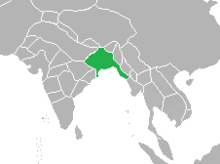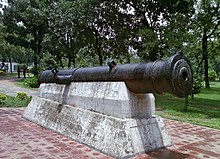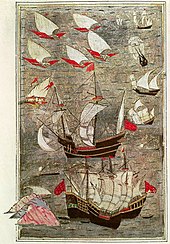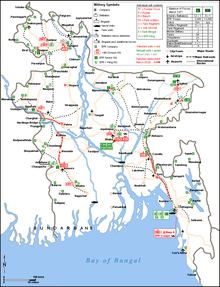Military history of Bangladesh

Bangladesh's military history is intertwined with the history of a larger region, including present-day India, Pakistan, Nepal, Bhutan and Myanmar. The country was historically part of Bengal – a major power in South Asia and Southeast Asia.
Muslims brought new military technology to the region after the 12th century. According to
A
Since contributing forces to the
The 2008 Bangladesh–Myanmar naval standoff was a notable event of modern Bangladeshi military history.
Early history
Pre-Islamic Era
The early
Pala period
The Bengal region crystallized as an imperial power during the 8th-11th century
Sultanate period
The
In the 14th century, Sultan
Bengal Sultanate

The
Invasion of Sher Shah

Isa Khan's campaigns
After the Bengal Sultanate collapsed in the late 16th-century, the aristocrat
Mughal period

Bengal remained relatively stable and prosperous during the 17th century. A key challenge during the early Mughal period was
Forts
Mud forts were common in Bengal, such as the Ekdala Fort used in the

Artillery

The artillery was a vital part of the Bengal military. The Mughal emperor Babur saw it as a very effective part of the Bengal army. Portuguese historian João de Barros opined that the military supremacy of the Bengal army over that of Arakan and Tripura was due to the efficiency of its artillery. The artillery used cannons and guns of various sizes.[8] The Bibi Mariam Cannon and the Jahan Kosha Cannon are examples of early modern Bengali artillery.
Bengal was a major exporter of
Mercenaries
Foreign mercenaries were an important part of the Bengal Sultanate army. Bengal recruited mercenaries from Abyssinia.[9]
Shipbuilding
In the 14th century,
The British Royal Navy had many of its ships built in Chittagong, including vessels used in the Battle of Trafalgar.
Colonial military history
The
- Fort William from the East India Company
- Siraj-ud-Daulah, the last independent Nawab of Bengal
- Anglo-Nepalese War- leads to Treaty of Sugali with Nepal and Treaty of Titalia (signed in Tetulia) with Sikkim
- First Anglo-Burmese War- Burmese forces invade Chittagong Division
- Indian Rebellion of 1857- includes revolt by the Bengal Army in Dhaka, Chittagong and Sylhet
- Bengal Duars, including parts of Panchagarh District
- Allied Forces of World War II stationed in Chittagong, Comilla, Dhaka and Sylhet; Imperial Japanese Army Air Servicebombs Chittagong
There was strong opposition to British involvement against the Turkish War of Independence, as both Mustafa Kemal Atatürk and the Ottoman caliphate enjoyed support in Bengal.
| Name of Conflict | Belligerents | Outcome | |
|---|---|---|---|
| Allies | Opponent(s) | ||
| Second Opium War (1856–1860) |
Victory
| ||
Ambela Campaign (1863–1864) |
Afghan Pashtuns tribes
Yusufzai |
Victory
| |
Bhutan War (1864–1865) |
Victory
| ||
British Expedition to Abyssinia (1867–1868) |
Victory
| ||
| Second Anglo-Afghan War (1878–1880) |
Victory
| ||
| Mahdist War (1881–1899) |
Victory
| ||
| Anglo-Egyptian War (1882) |
Ahmed Orabi
|
Victory
| |
| Third Anglo-Burmese War (1885) |
Burmese Empire
|
Victory
| |
Third Black Mountain Expedition (1888) |
Yousafzai Afghans | Victory
| |
Sikkim Expedition (1888) |
Victory
| ||
Hunza-Nagar Campaign (1891) |
Hunza Nagar |
Victory | |
| Chitral Expedition (1895) |
Bajauri Afghan Tribesmen |
Victory
| |
| Anglo-Zanzibar War (1896) |
Zanzibar Sultanate
|
Victory
| |
| Tochi Expedition (1896) |
Waziris
|
Victory
| |
| Siege of Malakand (1897) |
پشتون Pashtun tribes
|
Victory
| |
First Mohmand Campaign (1897–1898) |
Victory
| ||
Tirah Campaign (1897–1898) |
Victory
| ||
| Boxer Rebellion (1899–1901) |
|
Victory
| |
| Second Boer War (1899–1902) |
|
Victory
| |
| British expedition to Tibet (1903–1904) |
Victory
| ||
| Bambatha Rebellion (1906) |
Zulu people | Victory
| |
Bazar Valley Campaign (1908) |
Zakka Khel clan of the Afridi
|
Victory
| |
| World War I (1914–1918) |
|
South African Republic
|
Victory
|
| Allied intervention in the Russian Civil War (1918–1920) |
|
Withdrawal
| |
| Turkish War of Independence (1919–1923) |
|
Armistice
| |
| Third Anglo-Afghan War (1919) |
Armistice
| ||
First Waziristan Campaign (1919) |
Victory
| ||
| Kuwait–Najd War (1919–1920) |
Victory
| ||
Iraqi revolt (1920) |
Victory
| ||
| Malabar rebellion (1921) |
Mappila Muslims
|
Victory
| |
| Pink's War (1925) |
Mahsud tribesmen | Victory
| |
Second Mohmand Campaign (1935) |
Victory
| ||
Second Waziristan Campaign (1936–1939) |
Victory
| ||
| World War II (1939–1945) |
|
Victory
| |
| Indonesian National Revolution (1945–1947) |
Withdrawal
| ||
Operation Masterdom (1945–1946) |
Withdrawal
| ||
Eastern wing of Pakistan
With the
Khwaja Wasiuddin was the most senior Bengali officer in the Pakistani military.
Bangladesh Liberation War


Following the victory of the
The Bangladesh Forces received modest assistance from the Indian Government soon after the start of the war.[22] On 3 December 1971, India-Pakistan war broke out and Indian troops enter Bangladesh allied with the Bangladesh Armed Forces.[23] On 16 December 1971 the Pakistani Military force in Bangladesh surrender to a joint force of Indian and Bangladesh forces.[24]
Post-independence
The newly formed Bangladeshi armed forces incorporated some of the units and guerrillas of the Mukti Bahini.
Modern period

Having relied primarily on
Until a peace accord was signed in 1997, the Bangladeshi military engaged in
Forces Goal 2030 was launched by the government of Prime Minister Sheikh Hasina to secure new equipment for the Bangladeshi military.
Bangladesh-Myanmar border
Standoffs have occasionally occurred at the
- 2008 Bangladesh–Myanmar naval standoff
- 2015 Bangladesh-Arakan Army border clash
See also
References
![]() This article incorporates text from this source, which is in the public domain. Country Studies. Federal Research Division.
This article incorporates text from this source, which is in the public domain. Country Studies. Federal Research Division.
- ^ a b c d e "Military - Banglapedia". En.banglapedia.org. Retrieved 27 September 2017.
- ^ a b "Gunpowder plots | Dhaka Tribune". Archived from the original on 29 September 2017. Retrieved 29 September 2017.
- ^ a b Saltpetre - Banglapedia
- ISBN 978-1-84774-062-5.
- ^ "Fakhruddin Mubarak Shah - Banglapedia". En.banglapedia.org. 5 May 2014. Retrieved 27 September 2017.
- ^ "Isa Khan - Banglapedia". En.banglapedia.org. 5 May 2014. Retrieved 27 September 2017.
- ^ "Fort - Banglapedia". En.banglapedia.org. 13 April 2015. Retrieved 27 September 2017.
- ^ Military - Banglapedia
- ^ "BENGAL – Encyclopaedia Iranica". Iranicaonline.org. Retrieved 27 September 2017.
- ^ "Shipbuilding Industry - Banglapedia". En.banglapedia.org. 14 December 2014. Retrieved 27 September 2017.
- ^ Chester Neal Tate, Governments of the world: a global guide to citizens' rights and responsibilities, Macmillan Reference USA/Thomson Gale, 2006, p. 205.
- ^ a b Heitzman, James; Worden, Robert, eds. (1989). "Pakistan Era". Bangladesh: A Country Study. Washington, D.C.: Federal Research Division, Library of Congress. p. 207.
- ^ Demons of December — Road from East Pakistan to Bangladesh
- ISBN 0-231-03625-6.
- ^ Bose, Sarmila (8 October 2005). "Anatomy of Violence: Analysis of Civil War in East Pakistan in 1971". Economic and Political Weekly. Archived from the original on 1 March 2007.
- ^ Matthew White's Death Tolls for the Major Wars and Atrocities of the Twentieth Century
- ^ Virtual Bangladesh : History : The Bangali Genocide, 1971 Archived 23 July 2011 at the Wayback Machine
- ^ Heitzman, James; Worden, Robert, eds. (1989). "Zia's regime". Bangladesh: A Country Study. Washington, D.C.: Federal Research Division, Library of Congress. pp. 37–40.
- ^ Ahmed, Helal Uddin (2012). "Mukti Bahini". In Islam, Sirajul; Jamal, Ahmed A. (eds.). Banglapedia: National Encyclopedia of Bangladesh (Second ed.). Asiatic Society of Bangladesh.
- ^ Uddin, Syed Mohd. Saleh (2012). "Bangladesh Air Force". In Islam, Sirajul; Jamal, Ahmed A. (eds.). Banglapedia: National Encyclopedia of Bangladesh (Second ed.). Asiatic Society of Bangladesh.
- ^ Kawakita, Atsuyo. "Bangladesh War of Independence. The history of Bangladesh Independence War". www.bengalrenaissance.com. Retrieved 3 October 2017.
- ^ "Unfinished agenda of the Liberation War". The Daily Star. 26 March 2016. Retrieved 3 October 2017.
- ^ "The Tangail Landings: A signal for victory". The Daily Star. 26 March 2015. Retrieved 3 October 2017.
- ^ "Witnessing the surrender". The Daily Star. 16 December 2012. Retrieved 3 October 2017.
- ^ a b Heitzman, James; Worden, Robert, eds. (1989). "Postindependence Period". Bangladesh: A Country Study. Washington, D.C.: Federal Research Division, Library of Congress. p. 211.
- ^ Khan, Muazzam Hussain (2012). "Osmany, General Mohammad Ataul Ghani". In Islam, Sirajul; Jamal, Ahmed A. (eds.). Banglapedia: National Encyclopedia of Bangladesh (Second ed.). Asiatic Society of Bangladesh.
- ^ a b Heitzman, James; Worden, Robert, eds. (1989). "Mujib coup". Bangladesh: A Country Study. Washington, D.C.: Federal Research Division, Library of Congress. pp. 32–36.
- JSTOR 2644413.
- ^ a b Heitzman, James; Worden, Robert, eds. (1989). "Restoration of Military Rule". Bangladesh: A Country Study. Washington, D.C.: Federal Research Division, Library of Congress. pp. 36–37.
- ^ "Bangladesh: Death at Night". Time. 8 June 1981. Archived from the original on 30 September 2007. Retrieved 10 September 2006.
- ^ "India-Bangladesh border conflict". BBC News. 18 April 2001.
- ^ Saikia, Jaideep (July 2003). "Terror Sans Frontiers: Islamic Militancy in North East India" (PDF). The Program in Arms Control & Domestic and International Security at the University of Illinois at Urbana-Champaign. Archived from the original (PDF) on 15 April 2015.
- ^ ULFA, an agent for India's enemies
- ^ Parthasarathy, G. (3 November 2005). "The Bangladesh Challenge". The Hindu Business Line (Opinion).
